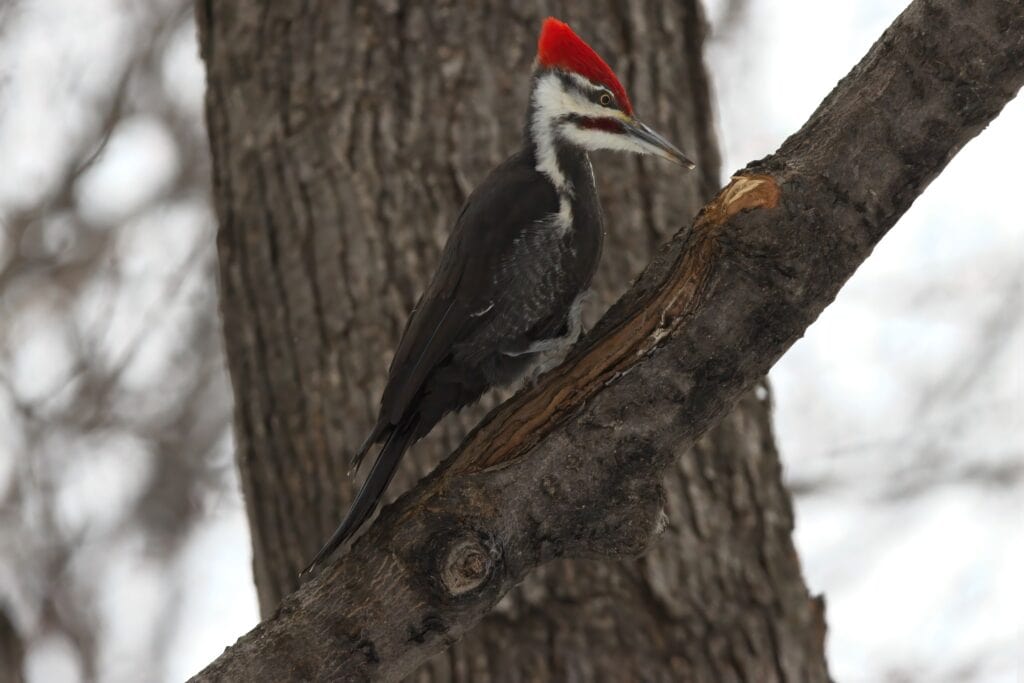North America’s woodlands are home to a whole host of strikingly beautiful and fascinating birds. From charming little chickadees to mysterious owls, North America is full of exceptional birds, but the Pileated Woodpecker manages to stand out even amongst such impressive company.
Pileated Woodpeckers are large, loud, and eye-catching, with black and white stripes on the face and neck and a brilliant red crest. The Pileated Woodpecker is often mistaken for the likely extinct Ivory-billed Woodpecker, a close relative of a similar size and coloring that was last seen in 2004. This coveted woodpecker is often called the “Lord God Bird” and is famous for ongoing efforts to locate a living specimen. Hoax sightings involving the Pileated Woodpecker are commonly reported, making the Pileated Woodpecker somewhat famous as a subject of mistaken identity. Their resemblance is only surface level, though. An experienced birder can easily tell the difference thanks in part to the Ivory-billed Woodpecker’s larger size, longer bill, and differences in patterning.
Related Article: Why Do Songbirds Sing So Much?
Fun Facts About the Pileated Woodpecker
The Pileated Woodpecker is a beautiful bird that deserves the attention it gets from birders. Let’s look at some Pileated Woodpecker fun facts to learn more about why these birds are so special!
Hammerhead: Like other woodpeckers, the Pileated Woodpecker forages for food by slamming its bill into trees, digging holes in wood, and tearing away bark. In the Pileated Woodpecker’s case, this is often done to get to the carpenter ants that make up a large portion of this bird’s diet. This foraging strategy produces a loud drumming sound that is often the first clue that a Pileated Woodpecker is nearby. It used to be widely thought that a specialized “spongy” bone in woodpeckers’ heads allow them to absorb the shock of this hammering behavior to prevent concussions, but recent research actually suggests that this spongy material might allow them to hammer more efficiently rather than more safely.
Neighborhood buffet: The Pileated Woodpecker’s hammering is quite a production. Pileated Woodpeckers excavate huge square-shaped holes in trees during their search for ants. These holes can be deep enough to break small trees in half. Because they excavate so much wood, smaller birds sometimes congregate to these excavation sites in hopes of gathering some tasty insects that the woodpecker has ignored. Other woodpeckers, and even smaller birds like wrens may be attracted to a Pileated Woodpecker’s excavation site.
Cozy constructions: Pileated Woodpeckers don’t just facilitate feasts for their smaller neighbors. They’re also the premiere home-builders of North America’s woodlands. Many birds require cavities for their nests. Barred Owls, for example, seek out cavities in trees to lay their eggs. They’re not the only ones. From bluebirds to martins, tons and tons of birds prefer to hole up in a cozy hole over building a nest from sticks or grasses. This can cause problems. In the case of the Eastern Bluebird, a shortage of available nest cavities can be a significant challenge to their populations. Fortunately, the Pileated Woodpecker is on the case! Not only do these birds build deep holes every time they hammer out ants, they also build cavities for their own nests. Each year they build a new cavity and the old one becomes an available resource for other birds!
The Future of the Pileated Woodpecker
Unlike its Ivory-billed cousin, the Pileated Woodpecker’s population is fairly stable. The International Union For the Conservation of Nature’s Red List of Endangered Species lists the Pileated Woodpecker as being of “Least Concern.” It is also experiencing an increase in numbers.
This bird may be on track to maintain a robust population, but it still faces significant challenges. In centuries past, deforestation was a major risk for these birds, because they rely heavily on large mature trees for both food and nesting. Fortunately, they have shown resilience in restored habitats as newly planted trees begin to mature.
Popular Article: Species Spotlight: The Arctic Tern

